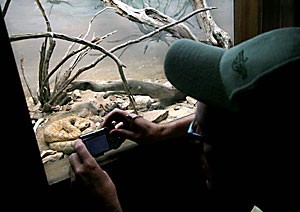Get ready for scorpions, spiders and snakes: Sept. 3-7 is Venom Week.
The UA’s VIPER Institute and the Arizona-Sonora Desert Museum are hosting a conference intended to bring together more than 250 national and international experts on venomous animals, treatment of bites and the medicinal applications of venom, said Jude McNally, managing director of the Arizona Poison and Drug Information Center.
Aimed at cutting fatality rates in victims of venomous animal bites and stings, the five-day conference at the Hilton Tucson El Conquistador Resort will be closed to the public, McNally said.
The curious can still catch a piece of the action, however.
Throughout the month of September, the Arizona-Sonora Desert Museum will feature a special display of all 18 varieties of rattlesnake native to Arizona, said Craig Ivanyi, the museum’s director of living collections and exhibits.
This is the first time the museum has had all 18 species shown at the same time, he added.
The display will also include a Mexican beaded lizard and a Gila monster.
“”This is definitely the rattlesnake capital of the United States,”” Ivanyi said, adding that Sonora, Mexico, is the only place in the world with more varieties.
VIPER stands for Venom, Immunochemistry, Pharmacology and Emergency Response – “”basically all of the things that go into treating an envenomated patient (including animals),”” McNally said.
Each year, McNally said he consults on 200-300 snakebites, roughly 2,700 scorpion stings and 500 spider bites – 100 of which are Arizona brown spider bites.
Rattlesnake venom contains more than 130 components, some of which could lead to new medications to treat diseases, he said. For example, a diabetes drug called Byetta is derived from the venom of the Gila monster.
Approximately 20-30 percent of rattlesnake bites are dry, meaning that the victim is not envenomated, McNally said, adding that if venom is deposited at the site of the bite, immediate symptoms include swelling and bleeding.
“”Time is tissue.
Time is tissue. The longer you wait to get treatment, the more these symptoms will present themselves.
-Jude McNally,
managing director, Arizona Poison and Drug Information Center
The longer you wait to get treatment, the more these symptoms will present themselves,”” he said. “”There’s never been any first aid in the field that’s been demonstrated that’s changed the outcome of a snakebite.””
Less than 0.1 percent of rattlesnake bites in Arizona result in fatality, he said. While that number is low, McNally said he focuses on further limiting morbidity and the long-term effects of envenomation.
Twenty-five percent of patients treated for snakebite in the U.S. permanently lose range of motion, and tissue strength and function from the bite, he said.
Worldwide, tens of thousands of people die from snakebites every year, primarily because of lack of availability or sophistication of health care, he added.
In Arizona, August and September are the months during which most rattlesnake bites occur, McNally said, adding that he consulted on 38 bites last month.
Treatment for a rattlesnake bite typically exceeds $100,000, half of which is typically the cost of the antivenin. A single vial of antivenin costs $2,000-3,000, and in 2006 the average patient received 20 vials, McNally said.









